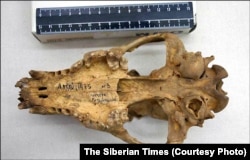Scientists have long sought an indisputable link showing when humans first domesticated dogs, steering a few receptive gray wolves' descendants toward lives as lapdogs.
The origins of their "domestic relationship" is one of the most hotly debated questions around dogs' undying loyalty to their masters and humankind’s unparalleled reliance on dogs to get a leg up on other predators in a frequently hostile environment.
Now, a team of interdisciplinary researchers has used DNA and other evidence to assert a "tandem movement" in and then beyond northeastern Siberia at a key stage of human and canid development late in the last Ice Age.
Their identification of eastern Russia as a wellspring of dog-domestication tens of thousands of years ago is a major contribution to the debate over when "the first recognizably domestic dog" appeared.
They say iced-in Siberians somehow teamed up with wolves more than 23,000 years ago on a relatively temperate patch that hosted prey like mammoths and steppe bison.
They speculate that thousands of years of geographical confinement prevented either side from straying too far and kept canine and human interlopers from disrupting the budding relationship.
Then, the team of transatlantic researchers say, those ancient Siberians and their "dogs" mixed with what would become the first migrants to North America, and possibly Eurasia.
Siberian puppies then dispersed alongside some of those travelers to become the precursors to modern dogs.
In other words, the DNA trail indicates that all of today's 900 million or so dogs -- a number that excludes other canids, like wolves and foxes -- descended from Siberian domestication.
"This evidence places constraints on when and where dog domestication took place," zooarchaeologist Angela Perri and six co-authors wrote in the peer-reviewed study, published in the February 9 edition of the Proceedings of the National Academy of Sciences (PNAS).
"Most significantly, it suggests that dogs were domesticated in Siberia by approximately 23,000 years ago, possibly while both people and wolves were isolated during the harsh climate of the Last Glacial Maximum," they said.
The study uses newly discovered archaeological sites and human-genome work to assert connections stretching further back than archaeological, paleontological, and other biological evidence could previously establish with any certainty.
"The new PNAS study is fantastic," says Audrey Lin from the Smithsonian's National Museum of Natural History.
Lin, who was not involved in the study, told RFE/RL "the arguments put forward by the authors about the timing and the origins of dog domestication make a lot of sense, given what we know about the archaeology and the genomics of early dogs."
The authors say wolf lineages suggest that dog domestication could have occurred as long as 40,000 years ago.
But crucially, they argue that it had to have taken place by the time ancient northern Siberians who lived and ate alongside the earliest dogs stopped mixing -- at least genetically -- with other groups for a period of at least a few thousand years before the ice age waned.
That joint isolation prodded along the human-wolf relationship as the Siberians relied increasingly on the canids to help stalk and hunt prey, to carry or pull heavy loads, and possibly, as toothy guards.
Sometime after the climate began to warm and ice sheets began to recede -- but with an ice corridor across the Bering Strait still connecting Siberia to North America -- the northern Siberians and their dogs began to mix and move again.
Wolf Vs. Dog
All dogs descended from a specific population of gray wolves that is thought to be long extinct.
"Dogs are essentially just wolves that have an evolved niche to scavenge human camps," David Ian Howe, an anthropologist and passionate domestication hobbyist who does a lot of public education on the human-dog relationship, told RFE/RL.
Some of the "proto-dogs," or "wolf-dogs," seem to have first appeared around 33,000 years ago, he said.
Then specialization began along a path toward the hundreds of breeds in the world today -- including artificial selection in favor of submissive traits that made it easier to co-exist with humans.
Individual historical specimens are most frequently classified as wolf or dog along genetic lines and according to physical characteristics.
In dogs, the most obvious bodily markers are tooth crowding and signs of gnawing on the kind of scraps that humans didn't want.
Other signs include a smaller skull size, a shorter snout, and a more gently sloping forehead.
But despite the interdisciplinary research and molecular dating, there is still disagreement over the classification of key specimens at Pleistocene-era archaeological sites, including at Goyet in modern Belgium and Predmesti in the Czech Republic.
That makes consensus difficult on when the first domestic dog appeared.
The earliest universally accepted specimen of a dog was found at Bonn-Oberkassel, in Germany. It is thought to be about 15,000 years old.
The authors of the PNAS study argue that they "take a conservative approach and only include those canids whose taxonomic status is unambiguously domestic."
Timing Is Everything
Scientists agree that dogs were the first domesticated animals.
It was one of prehistoric humans' most dramatic interventions in the natural world outside of agriculture.
But some have speculated that domestication could have happened multiple times in Europe, the Middle East, and East Asia.
One of the new PNAS paper's most important aspects is that it could explain how domesticated dogs seemingly appeared outside of East Asia in at least two of those places -- Europe and North America -- about 15,000 years ago.
"The convergence of the early genetic histories of people and dogs in Siberia and Beringia" -- the area around where Asia and North America meet -- "suggests that this may be the region where humans and wolves first entered into a domestic relationship," the PNAS paper says.
The authors acknowledge, however, that further archaeological research and analyses "are necessary to test this hypothesis."
Dispersing Together
The PNAS study shows that the forbearers of genetic populations of people and dogs from Siberia to North America, and the area in between, were already moving in synchronous ways late in the last ice age.
That, they say, suggests the humans' four-legged companions were already domesticated.
"We know that ancient Siberians were isolated in Beringia -- what is now the Bering Strait -- around 20,000 years ago, when much of the region was cold and inhospitable," said Kelsey Witt, a co-author and postdoctoral researcher at Brown University.
"For humans to be traveling with dogs during this period, if humans didn't domesticate dogs in Siberia, they either had to get them elsewhere in Eurasia before they became isolated -- making dog domestication occur very early -- or get dogs from elsewhere when the environmental conditions improved,” Witt said.
That, she said, would require a highly unlikely “very rapid eastward spread of dogs."
Some of those dogs' progeny eventually joined the "basal branch of Native Americans" in northeast Asia before leaving with them for the Americas, by boat or ice corridor.
Coming To America
The researchers say genetic and archeological trails clearly show that humans and dogs migrated together from Siberia to North America, where they settled and then "rapidly dispersed" again in "tandem" beginning about 15,000 years ago.
That conclusion is based in part on a mitochondrial DNA "signature" (A2b) that the PNAS study's authors say was shared by all ancient American dogs -- which split into four groups to populate the continent.
The mitochondrial evidence, they say, is built on an even firmer foundation of nuclear DNA classification of pre-Columbian dogs in the Americas.
It's unclear precisely how the dogs abandoned one group of ancient Siberians for another.
But in the eyes of Southern Methodist University (SMU) anthropologist and report co-author David Meltzer, that would have been easy enough.
"Dogs moving from one group to another didn't have to be anything particularly formal by way of trade," Meltzer told RFE/RL.
Meltzer said he's chased his share of “puppies running off."
"I can easily see dogs 'trading themselves,' as it were,” he said. “One group has dogs, the other doesn't, and as the two separate after a rendezvous, some of the puppies just take off after the previously dog-free group."
The earliest human inhabitants of the Americas and their canine fellow travelers left archaeological and genetic footprints virtually side-by-side as they wandered and settled in North America after their move from Siberia.
The Koster archaeological site, intermittently inundated by floodwaters of the Illinois River over thousands of years that deposited successive layers of soil, has been especially bountiful for tracking the human-dog relationship.
It encompasses dozens of former encampments dating back around 10,000 years and includes extensive evidence of domesticated dogs.
Three ancient dog burials at the Koster site and nearby are the oldest found in the Americas.
Really, Just Siberia?
Not everyone agrees with the new study’s attempt to poke genetic holes in the notion that Siberian dogs were initially domesticated elsewhere.
Peter Savolainen, the head of gene technology at Stockholm's Royal Institute of Technology, has argued that dogs were first domesticated in South Asia.
Savolainen says the PNAS paper's assertion that the "A2b haplogroup is virtually absent from outside of the Americas" is mistaken.
He says it "is found across the world, in numerous dogs” -- including dogs "in Africa, Asia, Europe."
"Therefore, the whole story falls, since it is this single thing...that is the basis for their conclusions," Savolainen told RFE/RL.
He also argues that "dating based on mitochondrial DNA is not very precise."
A geneticist among the PNAS paper's authors, paleogenomics professor Laurent Frantz from the Ludwig Maximilian University of Munich, adamantly rejected Savolainen's criticisms.
He said Savolainen's claims that the A2b exists in other dogs outside of the Americas is "mostly unsubstantiated except for a very few exceptions.”
Those exceptions, he said, “are easily explained" because they are very recent translocations "and do not contradict our findings at all."
Frantz also said his team's mitochondrial evidence is piled atop unique lineage that was "demonstrated using nuclear DNA, which is much more reliable than mitochondrial DNA."
Frantz suggested the mitochondrial criticism was "a bit irrelevant in the current state of genomics."
Away from the geneticists' lenses, research into human-canine interaction has bolstered a new branch of anthropology proponents call “ethnocynology” -- the study of dogs within past and present human societies.
Among them is anthropologist Howe, who has described domestication as "humanity's longest experiment in controlled evolution."
Howe has welcomed the PNAS study's conclusions.
He said “there will never be a definitive answer” until DNA tests can be performed on a dog that “erodes from the permafrost at that time” in history.
"But with that area being deemed the genetic area in which these dogs would have evolved,” Howe concluded, the PNAS study is “the closest we're going to get until then.”

















